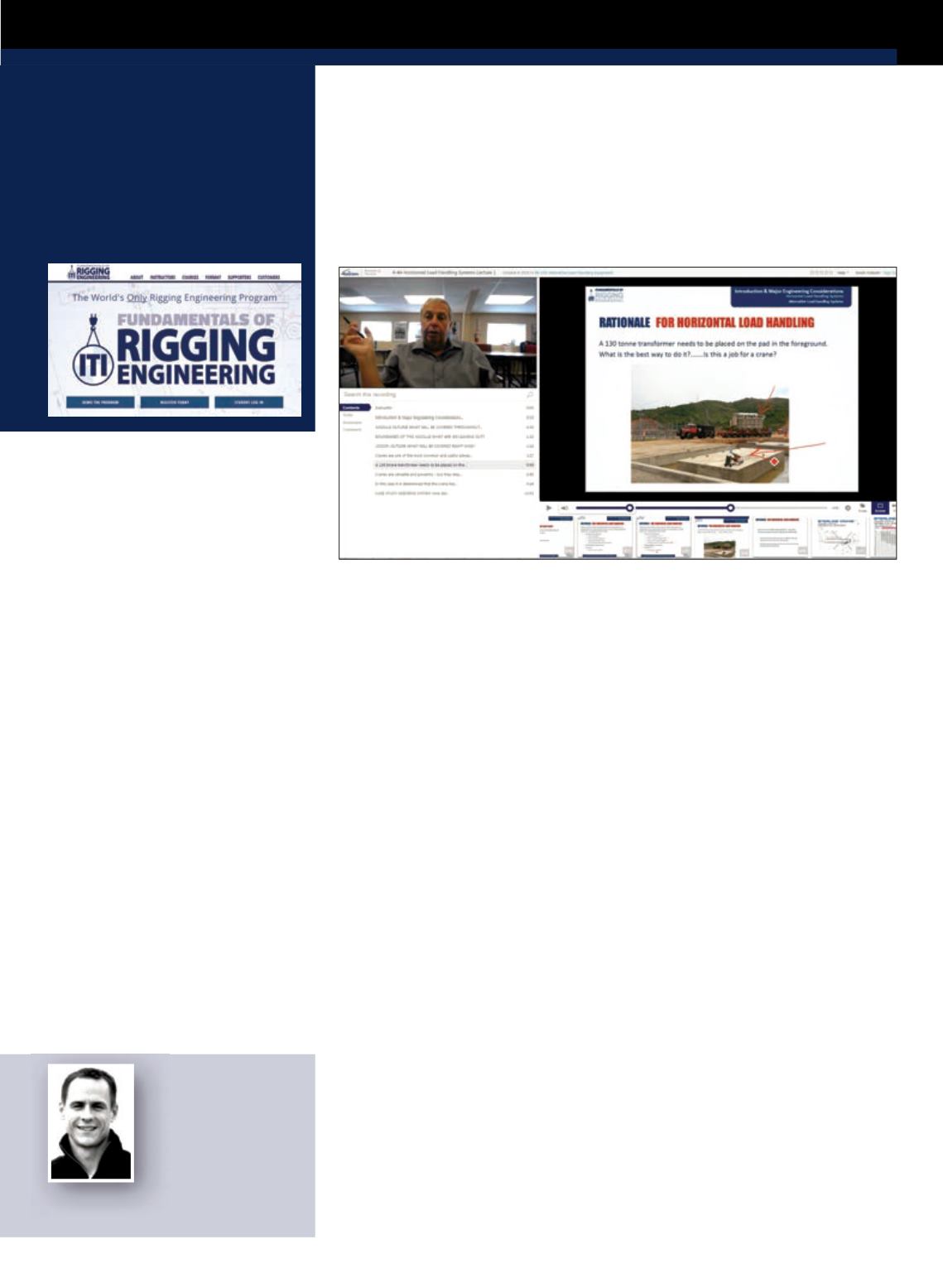
33
APRIL 2015
ACT
RIGGINGREVIEW
the samewayKHL andHarperCollins
arepublishers, ITI
is
apublisher of
sorts, publishingmassive amounts of
content in the formof books, reference
materials, lifting resources, training
programs, videos, andwhite papers. It’s
relevant tonote that the company also
has a “bookstore” division called ITI
Bookstore, saidbyParnell tobe “the
world’s largest sourcededicated to cranes,
rigging, and lifting resources.”
But books and referencematerials
weren’twhat Parnell was getting at in
our conversation. The content hewas
referring tohad todowith ITI’s newest
foray into educational content, the
Fundamentals of RiggingEngineering
Program
, released in Januaryof this
year, andbilledby theirwebsite as a
“a comprehensive introduction to the
science and art of the engineeringbehind
heavy rigging, lifting, and transport
activities.”
Arithmetic heavy
Thenewprogram, whichhas been
indevelopment since 2013, uses an
arithmetic-heavy curriculum to tie
together anumber of engineering
disciplines designed specifically to
educatepeople on the subject of rigging
engineering.
To complete the entireprogram,
studentsmust complete seven courses –
three from a list of required courses and
two from a list of elective courses. The
courses range in subjectmatter
from “Basic Structural Analysis and
Design” to “Horizontal LoadHandling
Systems.”
Theprogram’s structure is actuallyquite
simple: required courses encompass the
core elements of rigging engineering,
while electives allowparticipants to
select subjectsmore specific to skill
areas likeheavy transport, regulations,
and advancedhands-on rigging. In
fact, the
Fundamentals
program is a lot
like a college learning environment,
whichmakes sense, givenParnell’s
undergraduate experience atHawaii
PacificUniversity, wherehedouble
majored in international business and
marketing.
“Inundergrad, I usedBlackboard [an
online learning environment] and found
it pretty easy tonavigate,”Parnell said,
in a follow-upphone conversation.
“Whenwe thought about howwewanted
todistribute theprogram, we looked to
seewhat the top e-learning folkswere
doing.”
It occurred tome that that’swhat
most new companies dowhen trying to
launch anewproduct or service – survey
the landscape and seewhat else is out
there, seewho else is operating in their
space. Later in the conversation, Parnell
brought up another interestingpoint, one
that perhaps every company engaged in
contentmarketingof any sort needs to
contemplate.
A
t a receptionheldduring last
month’s SC&RASpecialized
Transportation Symposium,
I stood at ahigh-top tablenext toZack
Parnell, president of Industrial Training
International (ITI). At a few inches north
of six foot, Parnell is tall and lean and
often sharplydressed in fitted clothes
wthat contrast visibly against a room full
of polo shirts andwork jeans.He’s built
like a runner, butmentioned tome
that he spent his college years playing
baseball.He’s inhis late twenties, too
–part of thenew generationof folks
coming into theheavy construction
industrywith fresh approaches, outlooks
andproducts.
While frantically trying to flagdown
a serverwalking aroundwith a trayof
half-dollar size crab cakes, Parnell and I
werediscussing contentmarketing, and,
specifically, how an industry like crane
and rigging– an industry that canbe
somewhat antiquated in its approach to
marketing– can embrace it.
“We thinkof ourselves as a content
company,” he said, pausing toponder his
words before continuing. “Content comes
easy tous becausewe’republishers.”
It’s an interestingway to think about
a company in the construction space.
Though certainlynot publishers in
E-learning
engineering
TimHillegonds
discusses
ITI’s new ‘Fundamentals
of Rigging Engineering’
program.
THEAUTHOR
TimHillegonds
spent
a decade in the heavy
construction insurance
industry before founding
Thrive Content Solutions,
a copywriting agency dedicated to helping
businesses tell their stories.


